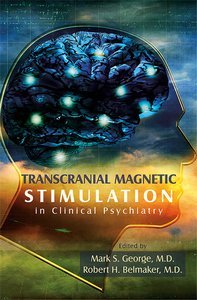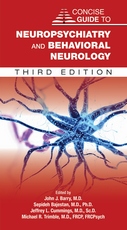Transcranial Magnetic Stimulation in Clinical Psychiatry
View Pricing
Description
As understanding evolves about how different brain regions are involved in carrying out everyday tasks—and in causing brain diseases when they go awry—this book describes a new technology that allows physicians to focally stimulate the brain in awake adults through a non-invasive procedure. Transcranial Magnetic Stimulation in Clinical Psychiatry is an accessible and authoritative review of TMS, a procedure that is showing promise as a treatment in several disorders. Its authors explain how the procedure works, then the latest findings in a wide range of situations—notably in depression, but also in other conditions ranging from migraine to stroke recovery.
This concise overview of TMS offers practical guidance for psychiatrists and other clinicians using it as a therapy, or referring their patients to have this done, as well as updating the field for neuroscientists and neurologists. It begins with background on the physics and safety of TMS, a guide for administering the procedure, and a review of basic neurophysiological studies with TMS, showing how it can be used to measure connectivity and excitability of the cerebral cortex. The heart of book is then devoted to its clinical applications, organized by disorder:
- Epilepsy, movement disorders, and pain—describes the use of TMS in inducing and inhibiting seizures and investigating their pathophysiology; in treating Parkinson's disease; and in relieving pain through motor cortex stimulation
- Major depression—provides a critical review of research in the most-studied clinical application of TMS in psychiatry, where it is used as a therapeutic intervention and a neurophysiological probe
- Mania—explores the effectiveness of TMS in light of its ECT-like properties through a trial of right TMS vs. sham TMS
- Anxiety disorders—reports on investigations on the uses of TMS in treating obsessive-compulsive disorder and posttraumatic stress disorder
- Schizophrenia—reviews studies utilizing single- or paired-pulse TMS to assess cortical inhibition and those that explore effects of extended trains of repetitive TMS in altering symptoms
A further chapter on TMS in brain imaging shows how integrating imaging and TMS allows one to better place the TMS coil, better understand TMS effects on the brain, and improve understanding of how the brain mediates behavior. With a concluding overview of prospects for the future of repetitive TMS, this volume offers a definitive look at this cutting-edge research and provides critical guidance on how and when clinicians might use TMS in their practice.
Contents
- Contributors
- Chapter 1. Overview of transcranial magnetic stimulation: history, mechanisms, physics, and safety
- Chapter 2. Methods of administering transcranial magnetic stimulation
- Chapter 3. Basic neurophysiological studies with transcranial magnetic stimulation
- Chapter 4. Transcranial magnetic stiumlation in epilepsy, movement disorders, and pain
- Chapter 5. Transcranial magnetic stimulation in major depression
- Chapter 6. Transcranial magnetic stiumulation in mania
- Chapter 7. Transcranial magnetic stimulation in anxiety disorders
- Chapter 8. Transcranial magnetic stimulation studies of schizophrenia
- Chapter 9. Transcranial magnetic stimulation and brain imaging
- Chapter 10. Repetitive transcratnial magnetic stimulation and related somatic therapies: Prospects for the future
- Epilogue for the Clinician
- Index
Contributors
- Berry Anderson, B.S.N., R.N.
Julia Applebaum, M.D.
R.H. Belmaker, M.D.
Daryl E. Bohning, Ph.D., D.A.B.R.
Jeffrey Borckardt, Ph.D.
Bella Chudakov, M.D.
Stewart Denslow, Ph.D.
Paulien M. De Vries, M.S.
Charles M. Epstein, M.D.
Mark S. George, M.D.
Benjamin D. Greenberg, M.D., Ph.D.
Nimrod Grisaru, M.D.
Mark Hallett, M.D.
Ralph E. Hoffman, M.D.
Richard Holt, M.D.
Kevin A. Johnson, B.E.
Alex Kaptsan, M.D.
Jejo Koola, B.S.
Samet Kose, M.D.
F. Andrew Kozel, M.D., M.S.C.R.
Xingbao Li, M.D.
Sarah H. Lisanby, M.D.
Jeffrey P. Lorberbaum, M.D.
Antonio Mantovani, M.D.
Christine Molnar, Ph.D.
Ziad Nahas, M.D., M.S.C.R.
Robert M. Post, M.D.
David Ramsey, M.S.
Komal Rastogi
Raffaella Ricci, Ph.D.
Alona Shaldubina, Ph.D.
Andrew M. Speer, M.D.
Ulf Ziemann, M.D.
About the Authors
Mark S. George, M.D., is Director of the Center for Advanced Imaging Research; Director of the Brain Stimulation Laboratory; and University Distinguished Professor of Psychiatry, Radiology, and Neurosciences at the Medical University of South Carolina in Charleston, South Carolina.
Robert H. Belmaker, M.D., is Hoffer-Vickar Professor of Psychiatry at Beer Sheva Mental Health Center and on the Faculty of Health Sciences at the Ben Gurion University of the Negev in Beersheva, Israel. He is President-elect of CINP, the International College of Neuropsychopharmacology.
Related Products
Carousel Control - items will scroll by tabbing through them, otherwise arrows can be used to scroll one item at a time








